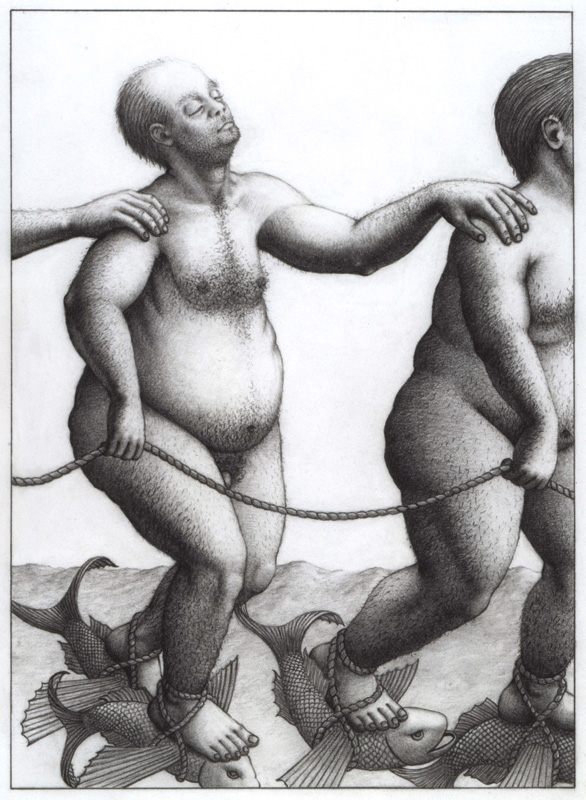
 |
| Three Blind Men Dreaming Away Their Sorrows 2002, graphite on paper 11 x 8 in. |
Three Blind Men Dreaming Away Their Sorrows |
For me the function of sketching and drawing generally falls into four distinct categories – to visually work out details of a larger image; to create new elements to add to my visual vocabulary; to create new work using that vocabulary; and finally to explore new ideas outside the boundaries of the vocabulary. The last category contains the purest form of experimentation. This often leads to the creation of new and unexpected images, which either open up other avenues to explore or, like Three Blind Men Dreaming Away Their Sorrows, become interesting side ventures that do not go beyond their singular creation. That is not to imply Three Blind Men Dreaming Away Their Sorrows is not a significant piece. I think it stands as an intriguing one in the context of my overall work and possibly beckons to have greater influence on future work. In that regard, I have recently been thinking more and more about the piece, wondering how I could incorporate various elements from it into my current work. For example, I see one its strengths as how its whimsical content relates to its undercurrent of loss and sorrow, and how that relationship results in a compelling tension. The whimsy in Three Blind Men Dreaming Away Their Sorrows is most obviously depicted by the overall scene. Three blind men, unabashedly naked and rotund, standing erect with one hand extended, grasping the shoulder of the figure in front of them while the other hand hangs down to hold onto a rope for guidance. They stride forward in unison with their feet bound to the backs of flying fish, floating above a body of water seemingly content with their situation. Other small details of the picture also convey a sense of humor. Their overly hairy bodies and balding heads, the rippling fat on their backsides, the disproportionately small size of the figure's penis, as well as the open-eyed "seeing" fish that are actually guiding the figures – but to what destination? The depiction of loss and sorrow in Three Blind Men Dreaming Away Their Sorrows is less obvious. The expression on the figure's face is one of contentment and, as the title suggests, conveys he is blindly dreaming away his sorrow. This implies a mental state of denial, escapism and sadness. As the metaphor of the "blind leading the blind" references, the three figures are ultimately tragic. After all they are being lead by the first in their group who cannot see or know where he is going and the followers blindly tag along. This brings up the question – where will this folly lead the trio of unfortunate men? On an endless journey across the vast stretches of ocean? To a watery grave? Only the fish know for sure. - Brian Mains, December 2019 |